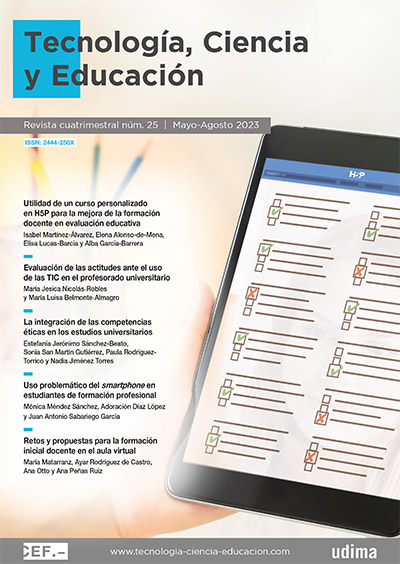Ramath: aplicación móvil para la enseñanza de matemáticas
DOI:
https://doi.org/10.51302/tce.2023.2800Palabras clave:
realidad aumentada, tecnologías inmersivas, casco de realidad aumentada, matemáticas, gamificación, educación, usos de la tecnología en educación, simulación por computadora, resolución de problemasResumen
Este trabajo presenta la aplicación móvil Ramath y su segunda versión utilizando un head mounted display (HMD). Ambas usan la realidad aumentada con el apoyo de mecánicas de juego en una aplicación no lúdica, orientada a ayudar a estudiantes (hombres y mujeres) de 12 a 15 años a aprender varias asignaturas de matemáticas. Asociamos conceptos como la «gamificación» y el «aprendizaje basado en problemas» (ABP) dentro de la aplicación, haciendo que los subproyectos sean mucho más interesantes para los estudiantes, animándolos a no tener miedo a las matemáticas, aprovechando la predisposición psicológica de los humanos a participar en juegos. Con la información recopilada en la investigación y la ayuda de un algoritmo predictivo, tratamos de mostrar hasta qué punto la tecnología puede ayudar en la educación.
Descargas
Citas
Argüelles, A. J., Cortés, H. D., Ramirez, O. E. P. and Bustamante, O. A. (2021). Technological spotlights of digital transformation: uses and implications under COVID-19 conditions. In Information Technology Trends for a Global and Interdisciplinary Research Community (pp. 19-49). IGI Global.
Arnaldi, B., Guitton, P. and Moreau, G. (2018). Virtual Reality and Augmented Reality: Myths and Realities. John Wiley & Sons.
Dimitrov, D. M. and Rumrill, P. D. (2003). Pretest-posttest designs and measurement of change. Work, 20(2), 159-165.
Estapa, A. and Nadolny, L. (2015). The effect of an augmented reality enhanced mathematics lesson on student achievement and motivation. Journal of STEM Education, 16(3), 40-48.
Evans, L. (2018). The Re-Emergence of Virtual Reality. Routledge.
Fidan, M. and Tuncel, M. (2019). Integrating augmented reality into problem based learning: the effects on learning achievement and attitude in physics education. Computers & Education, 142. https://doi.org/10.1016/j.compedu.2019.103635
Garzón, J., Kinshuk, Baldiris, S., Gutiérrez, J. and Pavón, J. (2020). How do pedagogical approaches affect the impact of augmented reality on education? A meta-analysis and research synthesis. Educational Research Review, 31. https://doi.org/10.1016/j.edurev.2020.100334
Hanafi, H. F., Said, C. S., Wahab, M. H. A. and Samsuddin, K. A. (2017). Improving students' motivation in learning ICT course with the use of a mobile augmented reality learning environment. IOP Conference Series: Materials Science and Engineering, 226, 1-11. http://dx.doi.org/10.1088/1757-899X/226/1/012114
Hays, R. T. (2005). The effectiveness of instructional games: a literature review and discussion. Naval Air Warface Center Training Systems Division.
Kaliciak, L., Myrhaug, H. and Goker, A. (2017). Content-based image retrieval in augmented reality. Advances in Intelligent Systems and Computing, 615, 95-103. https://doi.org/10.1007/978-3-319-61118-1_13
Kapp, K. M. (2012). The gamification of learning and instruction: game-based methods and strategies for training and education. John Wiley & Sons.
Kaur, N., Pathan, R., Khwaja, U. and Murthy, S. (2018). GeoSolvAR: Augmented Reality based solution for visualizing 3D solids. 2018 IEEE 18th International Conference on Advanced Learning Technologies (ICALT), 372-376. https://doi.org/10.1109/ICALT.2018.00093
Ke, F. (2009). A qualitative meta-analysis of computer games as learning tools. In R. E. Ferding, Handbook of Research on Effective Electronic Gaming in Education, 1-32. Information Science Reference.
Koehler, A. B., Snyder, R. D. and Ord, J. K. (2001). Forecasting models and prediction intervals for the multiplicative Holt-Winters method. International Journal of Forecasting, 17(2), 269-286. https://doi.org/10.1016/S0169-2070(01)00081-4
Lucas, P., Vaca, D., Domínguez, F. and Ochoa, X. (2018). Virtual circuits: an augmented reality circuit simulator for engineering students. 2018 IEEE 18th International Conference on Advanced Learning Technologies (ICALT), 380-384. https://doi.org/10.1109/ICALT.2018.00097
Lytridis, C. and Tsinakos, A. (2018). Evaluation of the ARTutor augmented reality educational platform in tertiary education. Smart Learning Environments, 5(1), 1-15.
Randel, J. M., Morris, B. A., Wetzel, C. D. and Whitehill, B. V. (1992). The effectiveness of games for educational purposes: a review of recent research. Simulation & Gaming, 23(3), 261-276.
Scavarelli, A., Arya, A. and Teather, R. J. (2021). Virtual reality and augmented reality in social learning spaces: a literature review. Virtual Reality, 25(1), 257-277.
Sitzmann, T. (2011). A meta-analytic examination of the instructional effectiveness of computer-based simulation games. Personnel Psychology, 64(2), 489-528.
Vogel, J. J., Vogel, D. S., Cannon-Bowers, J., Bowers, C. A., Muse, K. and Wright, M. (2006). Computer gaming and interactive simulations for learning: a meta-analysis. Journal of Educational Computing Research, 34(3), 229-243.
Weng, C., Rathinasabapathi, A., Weng, A. and Zagita, C. (2019). Mixed reality in science education as a learning support: a revitalized science book. Journal of Educational Computing Research, 57(3), 777-807.
Werrlich, S., Lorber, C. and Nguyen, P. (2018). Virtual, augmented and mixed reality: interaction, navigation, visualization, embodiment, and simulation. In J. Y. C. Chen and G. Fragomeni (Eds.), 10th International Conference, VAMR 2018, Held as Part of HCI International 2018, Las Vegas, NV, USA, July 15-20 (Vol. 10.909, pp. 462-476). Springer International Publishing. https://doi.org/10.1007/978-3-319-91581-4
Wolfe, J. (1997). The effectiveness of business games in strategic management course work. Simulation & Gaming, 28(4), 360-376.
Wu, H.-K., Lee, S. W.-Y., Chang, H.-Y. and Liang, J.-C. (2013). Current status, opportunities and challenges of augmented reality in education. Computers & Education, 62, 41-49.
Yoon, S., Anderson, E., Lin, J. and Elinich, K. (2017). How augmented reality enables conceptual understanding of challenging science content. Journal of Educational Technology & Society, 20(1), 156-168.
Descargas
Publicado
Cómo citar
Número
Sección
Licencia
Derechos de autor 2023 Amadeo José Argüelles Cruz, Hiram David Cortés Díaz, Octavio Elias Piñal Ramírez

Esta obra está bajo una licencia internacional Creative Commons Atribución-NoComercial-SinDerivadas 4.0.

























